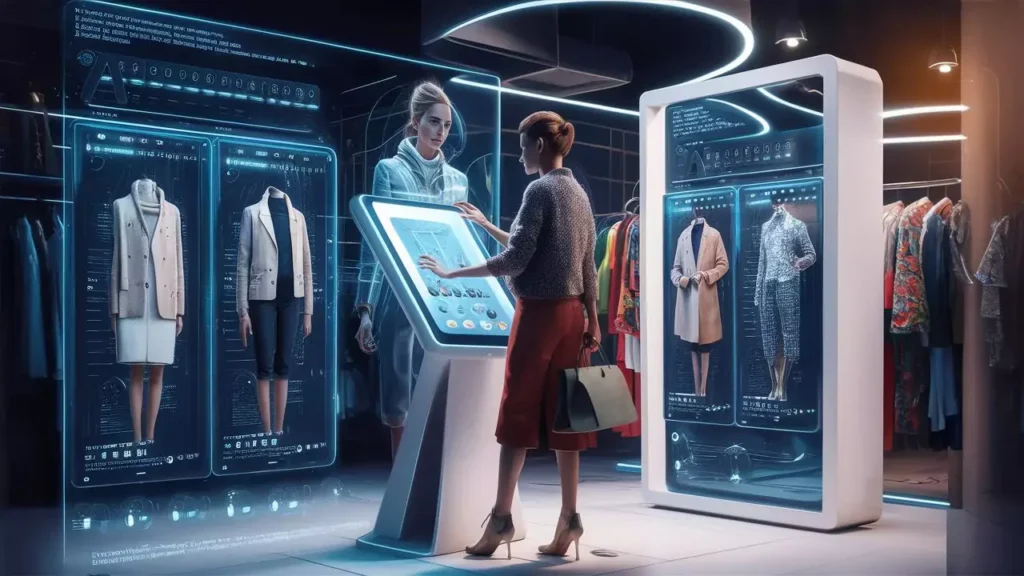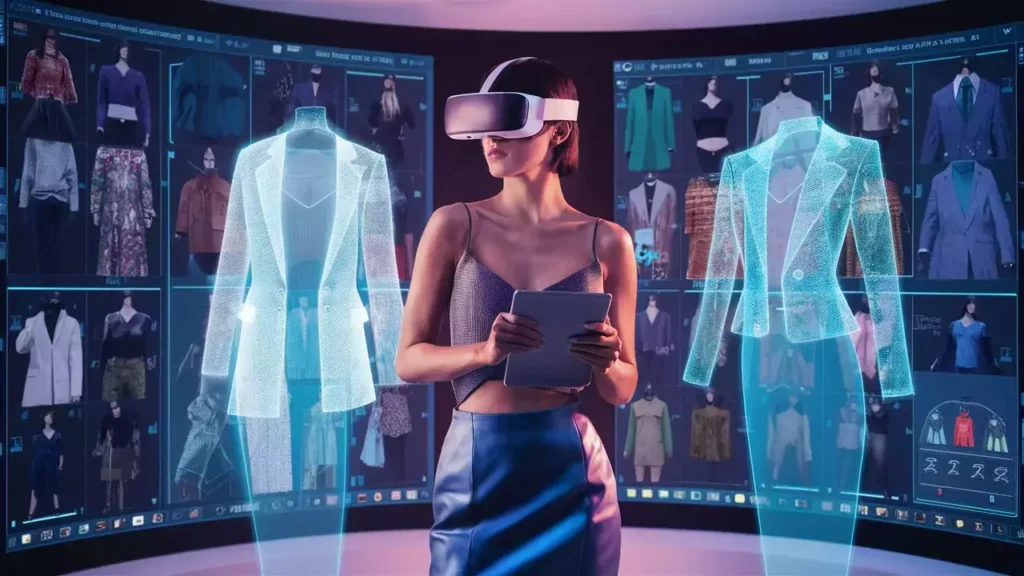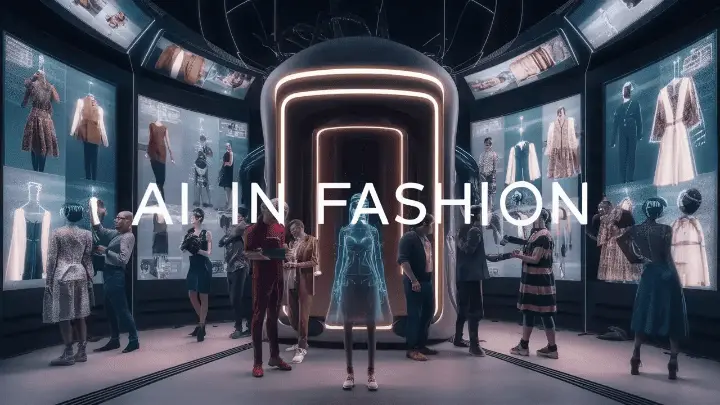Introduction
Artificial intelligence (AI) is revolutionizing industries worldwide, and the fashion industry is no exception. From design to manufacturing and marketing, AI-driven innovations are reshaping how fashion brands operate and engage with consumers. In this article, we will explore ten incredible ways artificial intelligence in fashion is transforming the industry.
The fashion industry is undergoing a radical transformation, and artificial intelligence (AI) is the driving force. Artificial intelligence is no longer just a buzzword; it’s an integral part of how designers create, brands market, and consumers shop. Get ready to discover how AI is making fashion smarter, more sustainable, and truly individual.
1. Personalized Fashion Recommendations

One of the most significant impacts of artificial intelligence in fashion is the ability to provide personalized fashion recommendations. Artificial intelligence algorithms analyze customer data, including past purchases, browsing history, and social media activity, to suggest products tailored to individual preferences.
How It Works
- Data Collection: AI systems collect data from various sources, including e-commerce websites, social media platforms, and mobile apps. This data includes customer demographics, purchase history, browsing patterns, and even social media activity.
- Analysis: Machine learning models analyze the data to identify patterns and preferences. By understanding what customers like and dislike, these models can predict future behavior and preferences.
- Recommendations: Personalized suggestions are generated and presented to the customer. These recommendations can appear as product suggestions on e-commerce websites, personalized emails, or targeted ads.
Benefits
- Enhanced Customer Experience: Customers receive tailored recommendations that match their tastes, improving their shopping experience.
- Increased Sales and Customer Loyalty: Personalized recommendations lead to higher conversion rates and repeat purchases, boosting sales and customer loyalty.
- Efficient Inventory Management: Retailers can stock products that align with customer preferences, reducing overstock and stockouts.
Example
Amazon’s recommendation engine is a prime example, using artificial intelligence to suggest products based on users’ behavior and preferences. This technology has significantly contributed to Amazon’s success by providing a highly personalized shopping experience.
2. AI-Powered Virtual Try-Ons
Virtual try-ons powered by AI are transforming the way customers shop for clothes online. These tools allow users to see how different outfits will look on them without physically trying them on.

How It Works
- Image Recognition: AI uses image recognition to map a customer’s body. Advanced algorithms analyze a customer’s photo to understand their body shape, size, and proportions.
- Simulation: Virtual models simulate how clothes will fit and look. AI generates a virtual avatar of the customer and applies the chosen outfits to this avatar, providing a realistic preview.
- User Interface: Customers interact with the virtual try-on tool to experiment with different styles. They can mix and match outfits, change colors, and view the outfits from various angles.
Benefits
- Reduces the Need for Physical Try-Ons: Customers can try on clothes virtually, saving time and effort.
- Minimizes Returns and Exchanges: Accurate virtual try-ons lead to better-fitting purchases, reducing the number of returns and exchanges.
- Enhances the Online Shopping Experience: Virtual try-ons make online shopping more interactive and engaging.
Example
Zara and ASOS have implemented virtual try-on features on their e-commerce platforms, allowing customers to visualize clothing on their virtual avatars. This innovation helps customers make more informed purchase decisions and enhances their overall shopping experience.
3. Artificial Intelligence and Fashion Design
AI is assisting designers in creating innovative fashion pieces by analyzing trends, predicting future styles, and generating new designs.
How It Works
- Trend Analysis: AI scans fashion trends across the internet, including social media, fashion blogs, and online stores. It identifies popular styles, colors, patterns, and materials.
- Design Generation: Machine learning algorithms create design patterns. These algorithms can generate new designs based on the analyzed trends, offering fresh and unique ideas.
- Collaboration: Designers use AI-generated insights to enhance their creativity. They can refine and customize AI-generated designs to create final products that align with their vision.
Benefits
- Accelerates the Design Process: AI speeds up the design process by providing quick access to trend data and generating design ideas.
- Inspires New and Unique Fashion Styles: AI can think outside the box, offering creative designs that human designers might not have considered.
- Improves Trend Forecasting Accuracy: AI provides accurate predictions of future trends, helping designers stay ahead of the curve.
Example
IBM’s Watson artificial intelligence has been used by fashion designers to analyze millions of images and generate design suggestions, aiding in the creative process. This collaboration between AI and designers leads to innovative and trend-setting fashion pieces.
4. Smart Fashion Technology
AI is driving the development of smart fashion technology, integrating wearable tech into clothing and accessories to provide enhanced functionalities.
How It Works
- Sensors and IoT: Smart clothing integrates sensors and Internet of Things (IoT) technology. These sensors can track various metrics such as physical activity, health indicators, and environmental conditions.
- Data Collection: Sensors collect data on physical activity, health metrics, and environmental conditions. This data is transmitted to a connected device, such as a smartphone, for analysis.
- Feedback: AI processes the data to provide real-time feedback. Users receive insights and recommendations based on the collected data.
Benefits
- Monitors Health and Fitness: Smart clothing can track physical activity, heart rate, and other health metrics, providing valuable health insights.
- Enhances User Convenience: Wearable tech offers functionalities like touch control for devices, navigation assistance, and more.
- Adds a Futuristic Element to Fashion: Smart fashion technology combines style with advanced functionalities, appealing to tech-savvy consumers.
Example
Levi’s Commuter Trucker Jacket with Jacquard by Google allows wearers to control their smartphone through touch gestures on the sleeve. This smart jacket exemplifies how fashion and technology can merge to create innovative and practical clothing.
5. Fashion AI Tools for Retail Management
Retail management is another area where artificial intelligence is making a significant impact, optimizing inventory, supply chain management, and customer service.
How It Works
- Inventory Management: AI predicts stock needs and automates restocking. Machine learning models analyze sales data and trends to forecast demand accurately.
- Supply Chain Optimization: Machine learning optimizes logistics and distribution. AI identifies the most efficient routes and methods for shipping, reducing costs and delivery times.
- Customer Service: AI-powered chatbots provide instant customer support. These chatbots can handle common inquiries, process orders, and offer personalized assistance.
Benefits
- Reduces Operational Costs: AI streamlines operations, reducing the need for manual intervention and cutting operational costs.
- Enhances Supply Chain Efficiency: Optimized supply chain management ensures timely deliveries and reduces stockouts and overstock situations.
- Improves Customer Satisfaction: AI-powered customer service provides quick and efficient support, enhancing the overall customer experience.
Example
H&M uses AI to analyze store receipts and returns to optimize inventory levels and predict future demand. This technology helps the brand maintain optimal stock levels and improve customer satisfaction by ensuring product availability.
6. AI-Driven Fashion Trends Analysis
AI helps brands stay ahead of the curve by analyzing vast amounts of data to identify emerging fashion trends.
How It Works
- Data Mining: AI mines data from social media, fashion blogs, and online stores. It collects information on what consumers are talking about, what they are buying, and what trends are emerging.
- Trend Identification: Algorithms identify and track rising trends. AI can recognize patterns and predict which styles are gaining popularity.
- Predictive Analysis: AI predicts future trends based on historical data. By analyzing past trends and consumer behavior, AI can forecast future fashion movements.
Benefits
- Keeps Brands Competitive: Identifying trends early helps brands stay competitive and relevant in a fast-paced industry.
- Informs Strategic Decision-Making: AI-driven insights inform product development, marketing strategies, and inventory decisions.
- Aligns Products with Consumer Demand: Brands can develop and stock products that align with current and future consumer preferences.
Example
Fashion tech company Heuritech uses artificial intelligence to predict trends by analyzing images and text from social media and fashion shows. Their technology helps brands like Louis Vuitton and Dior stay ahead of trends and make informed decisions.
7. Enhanced Marketing Strategies with AI
AI is transforming marketing strategies in the fashion industry by enabling more precise targeting and personalized marketing campaigns.
How It Works
- Customer Segmentation: AI segments customers based on behavior and preferences. Machine learning models analyze customer data to create detailed profiles and segments.
- Campaign Optimization: Machine learning optimizes marketing campaigns in real-time. AI adjusts targeting, messaging, and ad placements based on performance data.
- Content Creation: AI generates personalized content for different audience segments. From personalized emails to targeted social media ads, AI creates content that resonates with individual customers.
Benefits
- Increases Marketing ROI: Precise targeting and personalized campaigns lead to higher engagement and conversion rates, increasing the return on investment for marketing efforts.
- Enhances Customer Engagement: Personalized marketing messages resonate more with customers, leading to higher engagement and loyalty.
- Drives Higher Conversion Rates: Tailored marketing campaigns improve the chances of converting prospects into customers.
Example
Burberry uses Artificial Intelligence to personalize marketing messages and offers, resulting in more effective campaigns and increased customer engagement. Their AI-driven marketing strategies help them reach the right customers with the right messages at the right time.
8. AI in Sustainable Fashion
Sustainability is a growing concern in the fashion industry, and AI is playing a crucial role in promoting eco-friendly practices.
How It Works
- Sustainable Materials: AI identifies sustainable materials and designs eco-friendly products. Machine learning models analyze material properties and environmental impact to select the best options.
- Waste Reduction: Machine learning optimizes production processes to minimize waste. AI identifies inefficiencies and suggests improvements to reduce waste in manufacturing.
- Supply Chain Transparency: AI enhances transparency in the supply chain to ensure ethical sourcing. Brands can track the origin and journey of materials and products, ensuring they meet sustainability standards.
Benefits
- Reduces Environmental Impact: AI-driven sustainability practices help reduce the fashion industry’s carbon footprint and environmental impact.
- Promotes Ethical Fashion Practices: AI enables brands to adopt ethical sourcing and production practices, ensuring fair treatment of workers and responsible use of resources.
- Appeals to Eco-Conscious Consumers: As consumers become more environmentally conscious, AI-driven sustainable practices attract and retain these customers.
Example
Stella McCartney uses artificial intelligence to analyze and reduce the environmental impact of its products, from material sourcing to production processes. Their commitment to sustainability, supported by AI technology, sets an example for the industry.
9. AI for Fashion Forecasting
Accurate fashion forecasting is critical for brands to stay relevant and competitive. AI provides more accurate and timely forecasts than traditional methods.
How It Works
- Data Analysis: AI analyzes historical sales data, current market trends, and consumer behavior. Machine learning models process vast amounts of data to identify patterns and predict future trends.
- Predictive Modeling: Machine learning models predict future demand and trends. These models consider various factors, including seasonality, economic conditions, and consumer preferences.
- Real-Time Updates: AI provides real-time updates on changing trends and consumer preferences. Brands can adjust their strategies quickly based on the latest insights.
Benefits
- Improves Inventory Management: Accurate forecasts help brands maintain optimal inventory levels, reducing overstock and stockouts.
- Enhances Product Planning: Brands can plan their product lines based on predicted trends, ensuring they meet consumer demand.
- Reduces Overproduction and Waste: By aligning production with demand, brands can minimize overproduction and reduce waste.
Example
Zalando uses artificial intelligence for fashion forecasting, helping the company to predict trends and adjust inventory accordingly. This technology allows them to stay ahead of consumer demand and maintain efficient inventory management.
10. AI-Enhanced Customer Experiences
Artificial Intelligence is enhancing customer experiences in the fashion industry by providing personalized interactions, virtual assistants, and improved customer service.
How It Works
- Virtual Assistants: AI-powered virtual assistants help customers with shopping decisions. These assistants can provide style advice, suggest products, and assist with sizing.
- Chatbots: AI chatbots provide instant support and answer queries. They can handle a wide range of customer inquiries, from order status to product recommendations.
- Personalized Interactions: AI personalizes customer interactions based on their preferences and behavior. Customers receive tailored messages, offers, and support.
Benefits
- Enhances Customer Satisfaction: Personalized and efficient interactions lead to higher customer satisfaction and loyalty.
- Increases Engagement and Loyalty: AI-driven customer experiences foster deeper engagement and long-term loyalty.
- Streamlines the Shopping Experience: Virtual assistants and chatbots make the shopping experience more convenient and enjoyable.
Example
Nordstrom uses AI-powered chatbots to assist customers with their shopping needs, providing personalized recommendations and support. This technology helps Nordstrom deliver a superior customer experience and build stronger relationships with their customers.
Conclusion
The integration of artificial intelligence in fashion is not just a trend; it’s a paradigm shift. AI is no longer an optional tool but a necessity for brands that want to thrive in the 21st century. As AI technology continues to evolve and mature, we can expect even more groundbreaking innovations that will redefine how we create, shop for, and experience fashion. From hyper-personalized shopping journeys to sustainable, on-demand production, the future of fashion is inextricably linked with AI, promising a world where style is not only a form of self-expression but also a reflection of cutting-edge technology.

